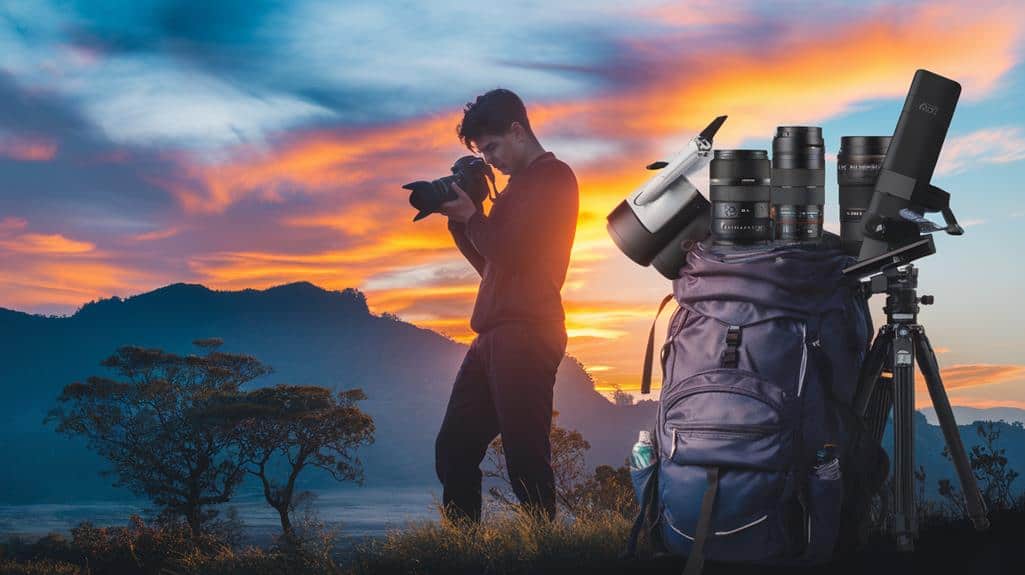
10 Best Camera Gear Picks for Travel Photographers
As a travel photographer, you'll want to equip yourself with versatile, durable gear that balances performance and portability. Essential picks include a mirrorless camera like the Sony A7 IV, a compact carbon fiber tripod, and a wide-angle zoom lens (16-35mm). Don't forget a weather-resistant camera backpack, portable external hard drive, and lightweight prime lens (35mm f/1.8) for creative shots. Round out your kit with ND and polarizing filters, a reliable backup battery pack, and a sturdy camera strap. For unique perspectives, consider a compact drone. These carefully selected items will help you capture stunning images in diverse environments, ensuring you're prepared for any photographic opportunity that arises during your travels.
In a Nutshell
- A mirrorless camera like the Sony A7 IV balances performance and portability with weather-sealing and advanced features.
- A compact travel tripod made of carbon fiber or aluminum provides stability while remaining lightweight and packable.
- A versatile wide-angle zoom lens (16-35mm) with weather-sealing captures expansive landscapes and architecture.
- A durable, weather-resistant camera backpack with customizable compartments protects gear and ensures comfort during long trips.
- High-quality ND and polarizing filters enhance landscape photography by controlling light and reducing reflections.
Versatile Mirrorless Camera
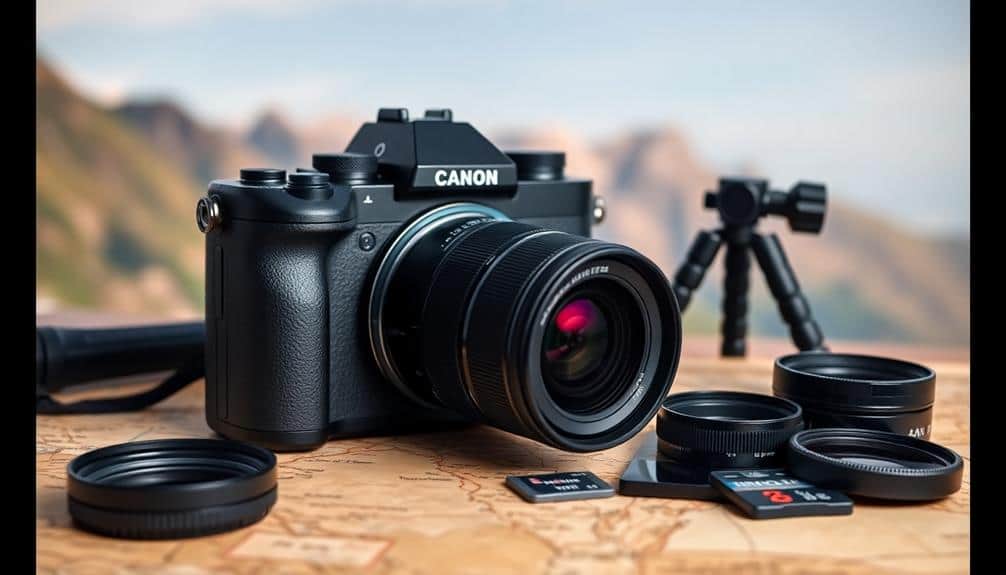
A versatile mirrorless camera is the cornerstone of any travel photographer's kit. You'll want a model that balances performance, portability, and durability. Look for features like weather-sealing, in-body image stabilization, and a robust autofocus system. The Sony A7 IV, for instance, offers a 33MP full-frame sensor, 10fps burst shooting, and 4K/60p video capabilities in a compact body. Mirrorless cameras offer a balance between image quality and lightweight design, making them ideal for travel photography. Consider the lens ecosystem when choosing your camera; a wide selection of native lenses guarantees you're prepared for any shooting scenario. Pay attention to battery life, as longer-lasting batteries are essential for extended shooting sessions. Don't overlook the importance of a comfortable grip and intuitive controls, which can make a significant difference during long days of shooting. Ultimately, select a camera that aligns with your specific travel photography needs and skill level.
Compact Travel Tripod

Packing a compact travel tripod can elevate your travel photography game. When selecting one, prioritize lightweight materials like carbon fiber or aluminum, which offer strength without adding bulk to your kit. Look for models with folded lengths under 16 inches, making them easy to stow in carry-on luggage or backpacks. Consider the maximum height and load capacity, ensuring they meet your needs for both camera weight and shooting scenarios. Features like reversible legs, multi-angle positioning, and built-in monopod functionality enhance versatility in the field. Opt for quick-release plates compatible with your camera system for efficient setup and breakdown. Some top-rated options include the Peak Design Travel Tripod, Manfrotto Befree Advanced, and Gitzo Traveler Series, each offering unique benefits for different travel styles and budgets. Remember to factor in durability and weather resistance for varied environmental conditions you'll encounter on your journeys. When evaluating stability, keep in mind that ideal performance is achieved with a tripod capacity of 1.5 to 2 times the weight of your heaviest camera setup. Additionally, consider tripods with adjustable center columns to expand your height range and facilitate low-angle shots.
Wide-Angle Zoom Lens
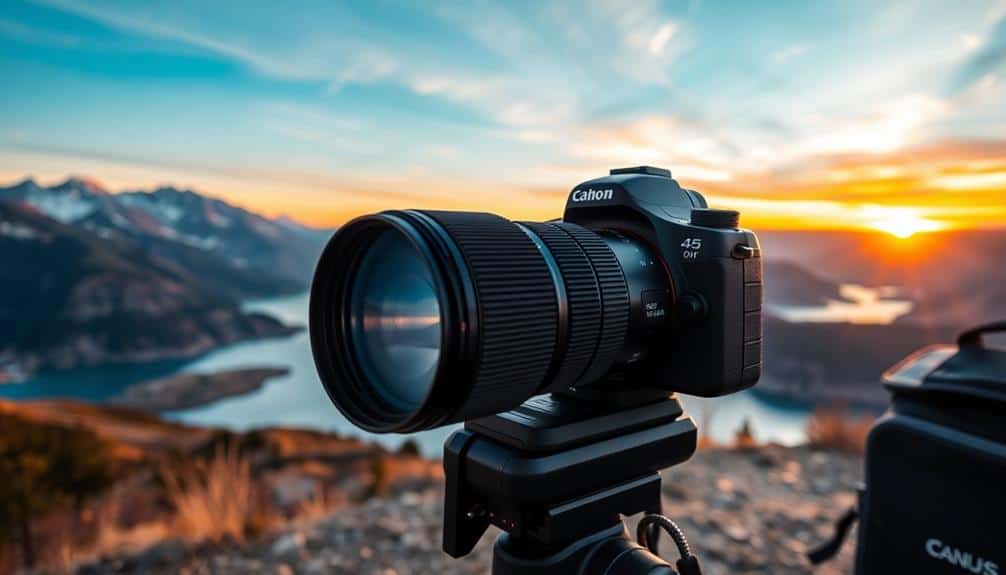
When it comes to capturing sweeping landscapes and cramped interiors, a wide-angle zoom lens is your secret weapon. Typically ranging from 16-35mm on full-frame cameras, these versatile lenses offer flexibility in framing while maintaining image quality. Look for models with a constant aperture of f/2.8 or f/4 for consistent exposure throughout the zoom range. Weather-sealing is vital for outdoor shoots, protecting against dust and moisture. Consider lenses with image stabilization to minimize camera shake in low-light conditions. Travel camera essentials include wide-angle zoom lenses, which are indispensable for capturing the essence of your journey. When selecting a lens, prioritize features that align with your travel photography style and destinations. Opt for high-quality glass elements, such as fluorite or aspherical, to reduce chromatic aberration and distortion. Pay attention to the minimum focus distance, which can be as close as 11 inches in some models, allowing for creative close-up shots. When choosing, balance factors like weight, size, and price against your specific travel photography needs and budget constraints.
Portable External Hard Drive
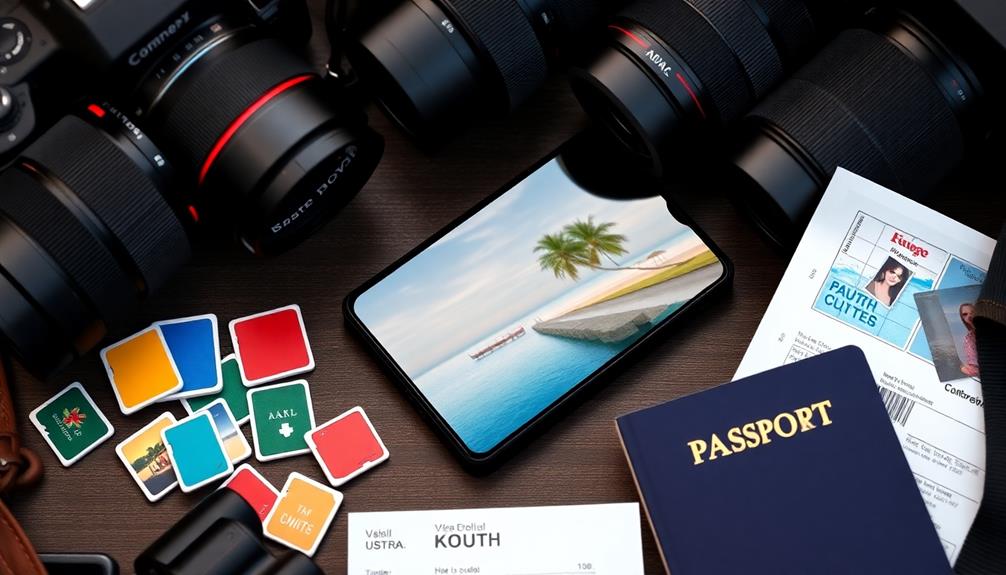
While capturing stunning images is paramount, safeguarding your work is equally important. A portable external hard drive is an essential tool for any travel photographer. When selecting the right drive, consider these key factors:
- Storage capacity (1TB to 5TB is typical)
- Read/write speeds (look for USB 3.0 or higher)
- Durability (shock-resistant and water-resistant models)
- Size and weight (compact for easy packing)
- Compatibility with your devices
Opt for a drive with automatic backup software to streamline your workflow. SSD drives, though pricier, offer faster performance and greater durability than traditional HDDs. Look for models with encryption capabilities to protect your data. Some photographers prefer rugged drives designed to withstand extreme conditions, featuring reinforced casings and IP ratings for dust and water resistance. Always bring multiple drives to create redundant backups, ensuring your precious images remain safe throughout your travels.
Weather-Resistant Camera Backpack
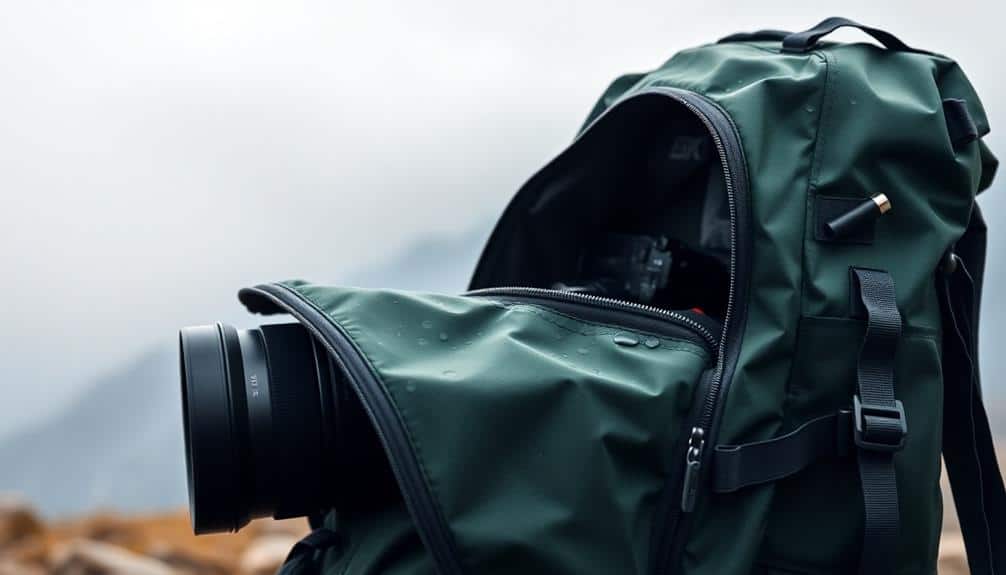
For travel photographers, a weather-resistant camera backpack is an indispensable piece of gear. You'll need a bag that can withstand various environmental conditions while protecting your valuable equipment. Look for backpacks with water-resistant or waterproof materials, sealed zippers, and reinforced bottoms. Many high-quality options feature customizable internal compartments, allowing you to organize your camera body, lenses, and accessories securely.
Consider backpacks with padded shoulder straps and breathable back panels for comfort during long shoots. Some models offer side access, enabling quick retrieval of gear without removing the entire pack. Pay attention to capacity, ensuring the backpack can accommodate your specific kit. Many weather-resistant camera backpacks also include laptop sleeves and external attachment points for tripods. When selecting a backpack, prioritize durability, ergonomics, and ease of use to enhance your travel photography experience.
ND and Polarizing Filters
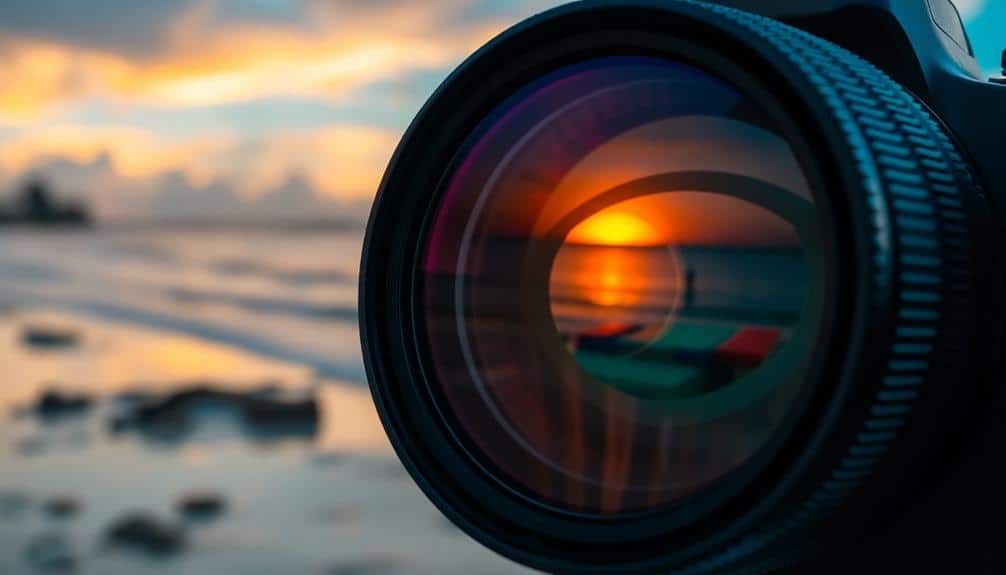
Travel photographers frequently rely on ND (Neutral Density) and polarizing filters to enhance their images. These essential accessories allow you to control light and reduce reflections, resulting in stunning landscape and outdoor shots. When selecting filters for your travel kit, consider these key factors:
- Filter size compatibility with your lenses
- Quality of glass and coatings
- Ease of stacking multiple filters
- Portability and durability for travel
- Versatility across various shooting conditions
Opt for a variable ND filter to adjust light reduction on-the-go, saving space in your bag. Circular polarizers are indispensable for managing reflections and enhancing colors, especially in scenes with water or sky. Invest in high-quality filters from reputable brands to guarantee exceptional image quality and longevity. Remember, using filters requires practice to master their effects, so experiment with different strengths and combinations to achieve your desired results.
Lightweight Prime Lens
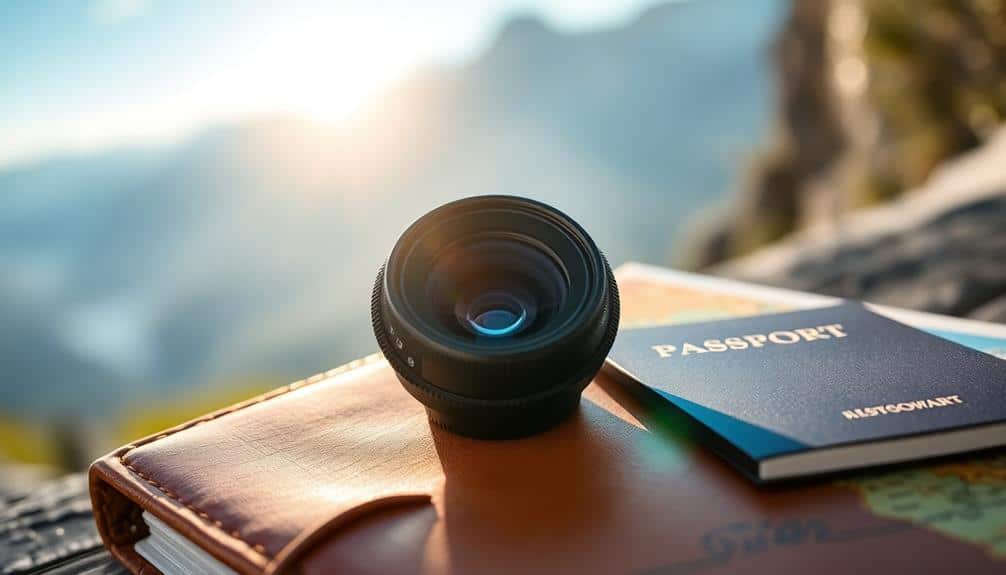
When it comes to packing light without compromising image quality, a lightweight prime lens is a travel photographer's secret weapon. These fixed focal length lenses offer superior sharpness and wider apertures compared to zoom lenses, allowing for exceptional low-light performance and beautiful bokeh. A popular choice is the 35mm f/1.8, which strikes a balance between versatility and compactness. Weighing typically between 200-300 grams, it's considerably lighter than most zoom lenses. Prime lenses also encourage creative composition, as you'll need to physically move to frame your shots. When selecting a lightweight prime, consider factors such as weather sealing, autofocus speed, and build quality. Look for models with metal mounts and high-quality glass elements for durability during travel. Remember, the simplicity of a prime lens can lead to faster shooting and less time changing lenses in dynamic environments.
Reliable Backup Battery Pack
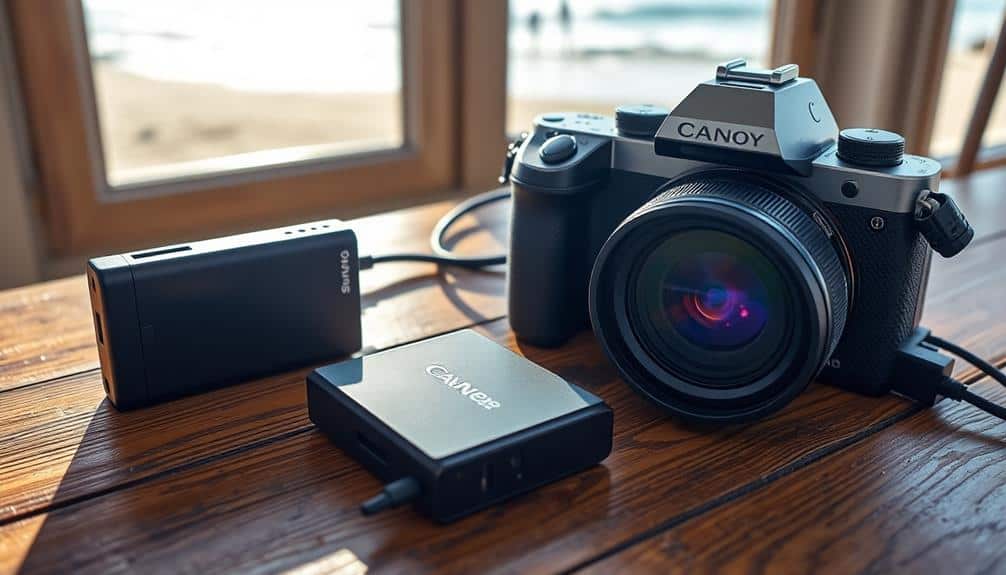
Powering through long days of shooting demands a reliable backup battery pack. When selecting one, strive to consider capacity, portability, and compatibility with your camera. Look for models offering quick-charge capabilities and multiple USB ports for charging various devices simultaneously. High-capacity packs, ranging from 20,000mAh to 30,000mAh, provide ample power for extended trips.
Key features to consider in a backup battery pack:
- Capacity (mAh)
- Number and type of output ports (USB-A, USB-C)
- Pass-through charging capability
- Compact size and weight
- Durability and weather resistance
Opt for reputable brands known for quality and safety standards. Some packs come with LCD screens displaying remaining charge and output wattage. For international travel, guarantee your chosen pack complies with airline regulations regarding lithium-ion batteries. With the right backup battery, you'll never miss a shot due to power issues.
Sturdy Camera Strap
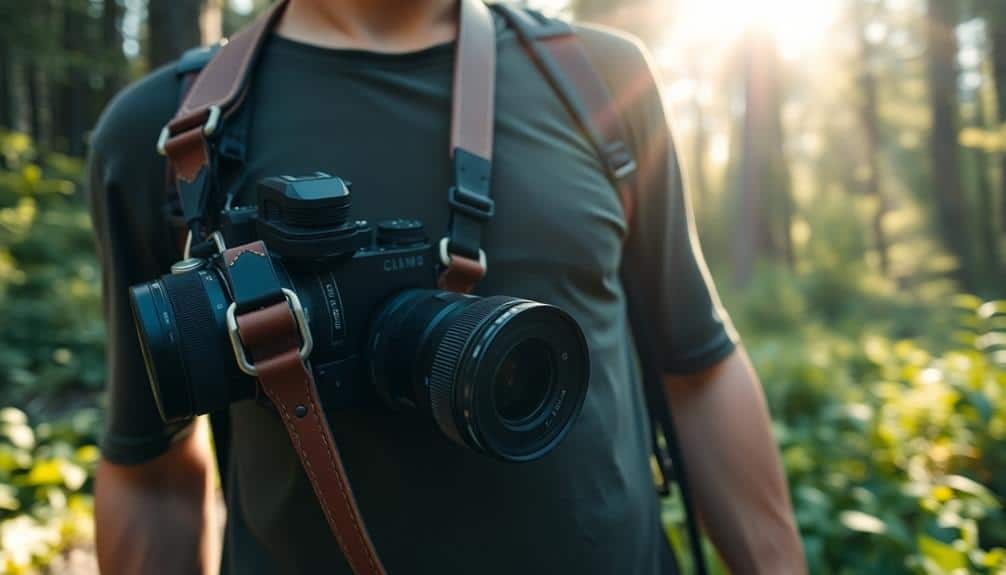
While a backup battery keeps your camera running, a sturdy camera strap guarantees it stays safely attached to you. When selecting a camera strap, prioritize comfort and durability. Look for straps made from high-quality materials like nylon or leather, with reinforced stitching at stress points. Opt for adjustable straps, typically ranging from 38 to 60 inches in length, to accommodate various carrying positions. Consider models with quick-release buckles for easy attachment and detachment.
For added security, choose straps with anti-theft features such as wire-reinforced webbing or slash-resistant materials. Some straps offer built-in storage for memory cards or lens caps, maximizing convenience. If you're using heavier gear, select wider straps (1.5 to 2 inches) to distribute weight evenly across your shoulder. Weatherproof straps with water-resistant coatings provide extra protection in unpredictable conditions, ensuring your gear remains secure throughout your travels.
Compact Drone for Aerial Shots
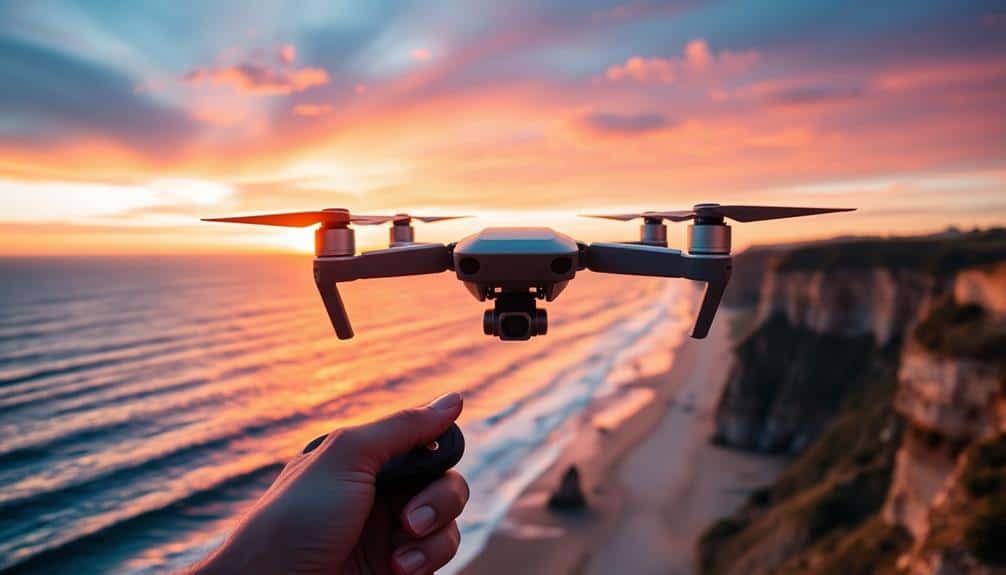
Why limit yourself to ground-level shots when you can capture stunning aerial perspectives? A compact drone is an essential tool for travel photographers seeking to elevate their imagery. When choosing a drone for your kit, consider these key factors:
- Size and weight for portability
- Flight time and range capabilities
- Camera quality and resolution
- Obstacle avoidance features
- Ease of use and control options
Look for models that fold down to fit in your backpack, offer at least 20 minutes of flight time, and feature 4K video capabilities. Advanced drones may include intelligent flight modes, allowing you to focus on composition while the drone handles complex maneuvers. Verify you're familiar with local drone regulations before flying, as rules vary by location. With practice, you'll be capturing breathtaking aerial shots that add a new dimension to your travel photography portfolio.
Frequently Asked Questions
How Do I Protect My Camera Gear From Theft While Traveling?
To protect your camera gear from theft while traveling, you'll want to employ several strategies. Use a non-descript camera bag that doesn't advertise expensive equipment. Always keep your gear close, especially in crowded areas. Consider using a camera strap with cut-resistant material. Invest in travel insurance that covers your equipment. When possible, utilize hotel safes or lockers. Be discreet when changing lenses or reviewing photos in public. Finally, maintain awareness of your surroundings and trust your instincts.
What's the Best Way to Clean Camera Equipment in Dusty Environments?
Imagine your camera drowning in a sandstorm! To prevent such a disaster, you'll need to be vigilant about cleaning your gear in dusty environments. Use a soft-bristled brush to gently remove loose particles, followed by a microfiber cloth for more stubborn debris. For sensitive areas like lenses, employ a blower to dislodge dust without contact. In extremely dusty conditions, consider using a protective cover or bag when not shooting. Regular maintenance, including sensor cleaning, is essential for ideal performance.
Are There Any Restrictions on Flying With Camera Batteries?
When flying with camera batteries, you'll need to follow specific airline regulations. Lithium-ion batteries must be carried in your carry-on luggage, not checked bags. There's typically a limit of 100Wh per battery, with a maximum of two spare batteries allowed. Larger batteries (100-160Wh) may require airline approval. Always check your airline's current policies, as they can change. It's advisable to use protective cases for your batteries and to tape the contacts to prevent short circuits.
How Can I Waterproof My Camera for Underwater Photography While Traveling?
Did you know that 71% of the Earth's surface is covered by water? To capture the underwater world, you'll need to waterproof your camera. You can use a waterproof housing, which is a custom-fitted case that protects your camera while allowing full functionality. Alternatively, consider a waterproof bag or pouch for less expensive protection. For casual use, waterproof compact cameras or action cameras are available. Always test your setup in shallow water before diving deeper, and don't forget to clean and dry your equipment thoroughly after use.
What's the Ideal Travel Insurance Coverage for Expensive Camera Equipment?
For expensive camera equipment, you'll want extensive travel insurance coverage that includes accidental damage, theft, and loss protection. Look for policies with high per-item limits, typically $2,500-$5,000, and overall coverage of at least $10,000-$15,000 for your gear. Guarantee the policy covers your specific destinations and activities, such as underwater photography. Consider add-ons like equipment rental coverage and trip interruption insurance. Always read the fine print to understand exclusions and deductibles before purchasing.
